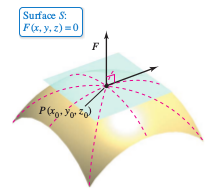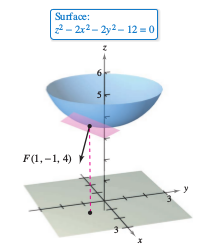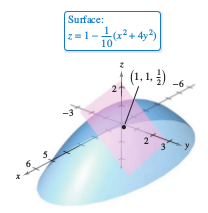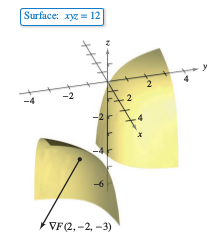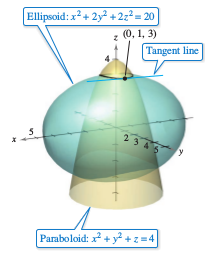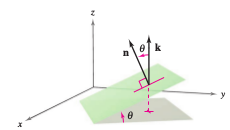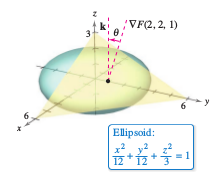Calculus III 13.07 Tangent Planes and Normal Lines
| Previous | Calculus III 13.06 Directional Derivatives and Gradients |
| Next | Calculus III 13.08 Extrema for Functions with Two Variables |
Contents
- 1 13.07 Tangent Planes and Normal Lines
- 1.1 Tangent Plane and Normal Line to a Surface
- 1.1.1 Example 13.7.1 Writing an Equation for a Surface
- 1.1.2 Definition 13.7.1 Tangent Plane and Normal Line
- 1.1.3 Theorem 13.7.1 Equation for a Tangent Plane
- 1.1.3.1 Example 13.7.2 Finding an Equation for a Tangent Plane
- 1.1.3.2 Example 13.7.3 Finding an Equation for a Tangent Plane Along the \(Z\)-Axis
- 1.1.3.3 Example 13.7.4 Finding an Equation for a Normal Line to a Surface
- 1.1.3.4 Example 13.7.5 Finding an Equation for a Normal Line to a Surface In Three Dimensions
- 1.2 The Inclination Angle for a Plane
- 1.3 Comparison Between Gradients \(\nabla f(x,y)\) and \(\nabla F(x,y,z)\)
- 1.1 Tangent Plane and Normal Line to a Surface
- 2 Internal Links
13.07 Tangent Planes and Normal Lines
- Find equations for tangent planes and normal lines to surfaces.
- Find a plane in three-dimensions, find the inclination angle.
- Compare the gradients \(\nabla f(x,y)\) and \( \nabla F(x,y,z)\).
Tangent Plane and Normal Line to a Surface
Thus far in the discussion surfaces in three-dimensions were described by equations with the form
- \( z=f(x,y). \:\:\:\:\)Equation for a surface \(S\)
From now on a more general description \(F(x,y,z)=0\) will be used. For a surface \(S\) given by \(z=f(x,y)\) can be converted to the general form by defining \(F\) as
- \(F(x,y,z) = f(x,y)-z\).
Because \(f(x,y)-z = 0\), consider \(S\) as the level surface for \(F\) given by
- \(F(x,y,z)=0 \:\:\:\: \)Alternative equation for a surface \(S\)
Example 13.7.1 Writing an Equation for a Surface
For the function
- \(F(x,y,z) = x^{2}+y^{2}+z^{2}-4\)
describe the level surface given by
- \(F(x,y,z) = 0. \)
Solution The level surface given by \(F(x,y,z) = 0 \) can be written as
- \( x^{2}+y^{2}+z^{2} =4\)
|
|
Normal lines are useful in applications involving curves. Normal lines are equally important in analyzing surfaces and solids. For example, consider a collision between two billiard balls. When a stationary ball is struck at a point \(P\) on its surface, it moves along the impact line determined by \(P\) and the ball's center. The impact can occur in two ways. When the cue ball is moving along the impact line, it stops dead and imparts all its momentum to the stationary ball, as shown in Figure 13.7.1. When the cue ball is not moving along the impact line, it is deflected to one side or the other and retains some momentum. The momentum that is transferred to the stationary ball occurs along the impact line, no matter what direction the cue ball takes, as shown in Figure 13.7.2. This impact line is called the normal line to the surface of the ball at the point \(P\). The process for finding a normal line to a surface also produces the tangent plane to the surface. Let \(S\) be a surface given by
and let \(P(x_{0},y_{0},z_{0}) \) be a point on \(S\). Let \(C\) be a curve on \(S\) through \(P\) that is defined by the vector-valued function \( \textbf{r}(t) = x(t)\textbf{i} + y(t)\textbf{j} + z(t)\textbf{k} .\) Then, for all \(t\), \(F(x(t), y(t), z(t)) = 0.\) If \(F\) is differentiable and \(x^{\prime}(t)\), \(y^{\prime}(t)\), and \(z^{\prime}(t)\) all exist, then if follows from the Chain Rule that
At \((x_{0},y_{0},z_{0})\), the equivalent vector form is
This result mean the gradient at \(P\) is orthogonal to the tangent vector for every curve on \(S\) through \(P\). Therefore, all tangent line on \(S\) lie in a plane that is normal to \( \nabla F(x_{0},y_{0},z_{0}) \) and contains \(P\), as shown in Figure 13.7.3 |
Definition 13.7.1 Tangent Plane and Normal Line
Let \(F\) be differentiable at the point \(P(x_{0},y_{0},z_{0})\) on the surface \(S\) given by \(F(x,y,z) = 0 \) such that
- \( \nabla F(x_{0},y_{0},z_{0}) \ne \textbf{0}. \)
1. The plane through \(P\) that is normal to \( \nabla F(x_{0},y_{0},z_{0}) \) is called the tangent plane to \(S\) at \(P\).
2. The plane through \(P\) having the direction for \( \nabla F(x_{0},y_{0},z_{0}) \) is called the normal line to \(S\) at \(P\).
To find an equation for th tangent plane to \(S\) at \((x_{0},y_{0},z_{0}) \), let \((x,y,z)\) be an arbitrary point in the tangent plane. Then the vector
- \(\textbf{v} = (x-x_{0})\textbf{i} + (y-y_{0})\textbf{j} + (z-z_{0})\textbf{k} \)
lies in the tangent plane. Because \( \nabla F(x_{0},y_{0},z_{0}) \) is normal to the tangent plane at \((x,y,z)\), it must be orthogonal to every vector in the tangent plane. Therefore,
- \( \nabla F(x_{0},y_{0},z_{0}) \cdot \textbf{v} = 0 \)
which leads to Theorem 13.7.1.
Theorem 13.7.1 Equation for a Tangent Plane
If \(F\) is differentiable at \((x_{0},y_{0},z_{0})\), then an equation for the tangent plane to the surface \(F(x,y,z) = 0 \) at \((x_{0},y_{0},z_{0}) \) is
- \( F_{x}(x_{0},y_{0},z_{0})(x-x_{0}) + F_{y}(x_{0},y_{0},z_{0})(y-y_{0}) + F_{z}(x_{0},y_{0},z_{0})(z-z_{0}) = 0.\)
To find an equation for the tangent plane at a point on a surface given by \(z=f(x,y)\), define \(F\) as
- \(F(x,y,z) = f(x,y)-z\).
Then \(S\) is given by the level surface \(F(x,y,x) = 0 \), and an equation from the tangent plane to \(S\) at the point \((x_{0},y_{0},z_{0}) \) is
- \( f_{x}(x_{0},y_{0})(x-x_{0}) +f_{y}(x_{0},y_{0})(y-y_{0}) - (z-z_{0}) = 0\).
Example 13.7.2 Finding an Equation for a Tangent Plane
|
|
Find an equation of the tangent plane to the hyperboloid
at the point \((1,-1,4)\).
Consider
which yields
At the point \((1,-1,4)\), the partial derivatives are
An equation for the tangent line at \((1,-1,4)\) is
The semi-hyperboloid and the tangent plane are shown in Figure 13.7.4. |
Example 13.7.3 Finding an Equation for a Tangent Plane Along the \(Z\)-Axis
|
|
Find the equation for the tangent plane to the paraboloid
at the point \((1,1,\frac{1}{2})\).
An equation for the tangent plan at \((1,1,\frac{1}{2})\) is
as shown in Figure 13.7.5. |
Example 13.7.4 Finding an Equation for a Normal Line to a Surface
|
|
Find the symmetric equations for the normal line to the surface
at the point \((2,-2,-3)\).
Then use the gradient to find the normal line.
Now apply the point \((2,-2,-3)\), which yields
The normal line at \((2,-2,-3)\) has direction numbers 6, -6, and -4, and the corresponding symmetric equations are
as shown in Figure 13.7.6. |
Example 13.7.5 Finding an Equation for a Normal Line to a Surface In Three Dimensions
|
|
Describe the tangent line where the curve and ellipsoid intersect,
at the point \((0,1,3)\), as shown in Figure 13.7.7.
The cross product for the gradients is a vector that is tangent to both surfaces at the point \((0,1,3)\).
Therefore, the tangent line to the curve intersecting both surfaces at the point \((0,1,3)\) is a line that is parallel to the \(x\)-axis and passes through the point \((0,1,3)\), as shown in Figure 13.7.7. | ||||||||||||||||||||||
The Inclination Angle for a Plane
|
|
Gradients can be used to find the inclination angle for a tangent plane to a surface. The inclination angle for a plane is defined as the angle \(\theta \:(0 \leqslant \theta \leqslant \pi/2)\) between the given plane and the \(xy\)-plane, as shown in Figure 13.7.8. The inclination angle for a horizontal plane is defined as zero. Because the vector \(\textbf{k}\) is normal to the \(xy\)-plane, the cosine formula for the angle between two planes, Section 11.5, can be used to conclude that the inclination angle for a plane with the normal vector \(\textbf{n}\) is
|
Example 13.7.6 Finding the Inclination Angle for a Tangent Plane
|
|
Find the inclination angle for the tangent plane to the ellipsoid
at the point \((2,2,1)\).
Calculating the gradient for \(F\) at the point \((2,2,1)\) is
Because \( \nabla F(2,2,1) \) is normal to the tangent plane and \( \textbf{k} \) is normal to the \(xy\)-plane, it follows that the inclination angle for the tangent plane is
which implies that
as shown in Figure 13.7.9. An alternative formula for the inclination angle \( \theta \) for the tangent plane to the surface \(z=f(x,y)\) at \((x_{0},y_{0},z_{0})\) is
|
Comparison Between Gradients \(\nabla f(x,y)\) and \(\nabla F(x,y,z)\)
The discussion so far has shown that the gradient for a function \(f\) with two variables is normal to the level curves for \(f\). Theorem 13.6.3 states that if \(f\) is differentiable at \((x_{0},y_{0})\) and \(\nabla f(x_{0},y_{0}) \ne \textbf{0}\), the \(\nabla f(x_{0},y_{0})\) is normal to the level curve throughout \((x_{0},y_{0})\). This result is easily extended to functions with three variables.
Theorem 13.7.2 Gradient Is Normal to Level Surfaces
If \(F\) is differentiable at \((x_{0},y_{0},z_{0})\) and
- \(\nabla F(x_{0},y_{0},z_{0}) \ne \textbf{0}\)
then \(\nabla F(x_{0},y_{0},z_{0}) \) is normal to the level surface through \((x_{0},y_{0},z_{0})\).
Internal Links
Parent Article: Calculus III 13 Functions with Several Variables


